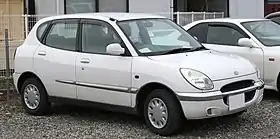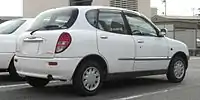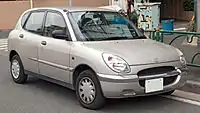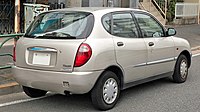Daihatsu Storia
The Daihatsu Storia (Japanese: ダイハツ・ストーリア, Daihatsu Sutōria) is a subcompact car which was produced by the Japanese automaker Daihatsu between 1998 and 2004, and was also sold as the Toyota Duet (Japanese: トヨタ・デュエット, Toyota Deyuetto) in Japan. It effectively replaced the similar sized Charade, which was produced alongside it for a year until being discontinued in 1999.
| Daihatsu Storia (M100) | |
|---|---|
 2000–2001 Daihatsu Storia (M100S; pre-facelift, Japan) | |
| Overview | |
| Manufacturer | Daihatsu |
| Also called |
|
| Production | February 1998 – June 2004 |
| Body and chassis | |
| Class | Subcompact car |
| Body style | 5-door hatchback |
| Layout | |
| Related | Daihatsu YRV |
| Powertrain | |
| Engine | |
| Power output |
|
| Transmission | |
| Dimensions | |
| Wheelbase | 2,370 mm (93.3 in) |
| Length | 3,660–3,690 mm (144.1–145.3 in) |
| Width | 1,600 mm (63.0 in) |
| Height | 1,435–1,450 mm (56.5–57.1 in) |
| Curb weight | 820–920 kg (1,808–2,028 lb) |
| Chronology | |
| Predecessor | Daihatsu Charade |
| Successor | Daihatsu Boon |
Outside Japan, with the exception of a few countries, the Storia was sold as the first generation Sirion.
The name "Storia" is Italian for "story".
Overview
The 1998 Storia/Duet (called Sirion outside Japan) came with two petrol engines (with multi-point fuel injection): a 989 cc three-cylinder engine with 44 kW (59 hp; 60 PS) and a 1.3 L four-cylinder engine with 64 kW (86 hp; 87 PS) unit. Both were available with either a 5-speed manual or a 4-speed automatic transmission. As of 2001, 1.3 L models have 76 kW (102 hp; 103 PS) engines capable of accelerating from 0–97 km/h (0–60 mph) in 9.6 seconds and reaching a top speed of 179 km/h (111 mph). This engine has an average fuel consumption of 21.1 km/L (60 mpg‑imp; 50 mpg‑US) and the 989 cc models averaging 21.85 km/L (61.7 mpg‑imp; 51.4 mpg‑US).
UK market only had the Rally versions of the Sirion: Rally 2 and Rally 4; the latter being the four-wheel drive version. The Rally models have a slightly increased engine output of 81 kW (109 hp; 110 PS) and has a 0–97 km/h (0–60 mph) time of 8.1 seconds (8.9 seconds for Rally 4) and reaching a top speed of 185 km/h (115 mph). The 4Track (or just 4WD outside Japan) is a four-wheel drive version of the standard 1.3 L model. The F-Speed is an automatic model which can be switched using a dashboard button to use push button sequential gear change on the steering wheel. A version called the Storia X4 was released for racing in Japan. This model has a four-wheel drive layout with front and rear limited-slip differentials and is powered by a JC-DET 713 cc engine producing 88 kW (118 hp; 120 PS). The use of a slightly enlarged kei car engine on the X4 was designed to meet homologation regulations for 1-liter racing class, which imposes a displacement multiplier for turbocharged engines, while allowing for larger body that is not constrained to kei car-size regulations.
The Storia/Duet was restyled in 2000 with most changes to the front of the car, most notably the grille design. From the A-posts rearward, the design remained almost identical. The dashboard was also extensively redesigned with innovative use made of storage space and a more luxurious appearance.
The Australian market only had the 989 cc model up until early 2001, when the sporty 1.3 L model, known as the GTvi, was added to the lineup. At the time, the GTvi model had the most powerful naturally aspirated engine available in its class, developing 75 kW (101 hp; 102 PS) at 7,500 rpm.
In Australia, a sequential transmission option was made available in the GTvi version only from 2002. This was an electronically controlled 4-speed automatic transmission with sequential mode activated by a dashboard switch, then gear selection by buttons on the steering wheel.
In December 2001, the Storia/Duet was restyled; the front grille and bumper were changed for a sportier appearance and in some markets the silver accents on the sides were removed (retained for the GTvi model in Australia). The dash and interior were redesigned, incorporating more storage spaces, easier to use controls and higher quality trim.
Gallery
 2000–2001 Daihatsu Storia (M100S; pre-facelift, Japan)
2000–2001 Daihatsu Storia (M100S; pre-facelift, Japan)_front.jpg.webp) Daihatsu Storia X4 (M112S, Japan)
Daihatsu Storia X4 (M112S, Japan)_rear.jpg.webp) Daihatsu Storia X4 (M112S, Japan)
Daihatsu Storia X4 (M112S, Japan)_hatchback_(2011-06-15).jpg.webp) 1998–2001 Daihatsu Sirion (M100RS; pre-facelift, Australia)
1998–2001 Daihatsu Sirion (M100RS; pre-facelift, Australia)_GTvi_hatchback_(20868629026).jpg.webp) 2000 Daihatsu Sirion GTvi (M101RS; pre-facelift, Australia)
2000 Daihatsu Sirion GTvi (M101RS; pre-facelift, Australia)_GTvi_hatchback_(23357641832).jpg.webp) 2003 Daihatsu Sirion GTvi (M101RS; facelift, Australia)
2003 Daihatsu Sirion GTvi (M101RS; facelift, Australia) 2003 Daihatsu Sirion F-Speed (M101RS; facelift, UK)
2003 Daihatsu Sirion F-Speed (M101RS; facelift, UK) 2003 Daihatsu Sirion F-Speed (M101RS; facelift, UK)
2003 Daihatsu Sirion F-Speed (M101RS; facelift, UK) Toyota Duet 1.0 V (M100A; pre-facelift, Japan)
Toyota Duet 1.0 V (M100A; pre-facelift, Japan) Toyota Duet 1.0 V (M100A; pre-facelift, Japan)
Toyota Duet 1.0 V (M100A; pre-facelift, Japan) Toyota Duet 1.0 V (M100A; facelift, Japan)
Toyota Duet 1.0 V (M100A; facelift, Japan)
| Wikimedia Commons has media related to |